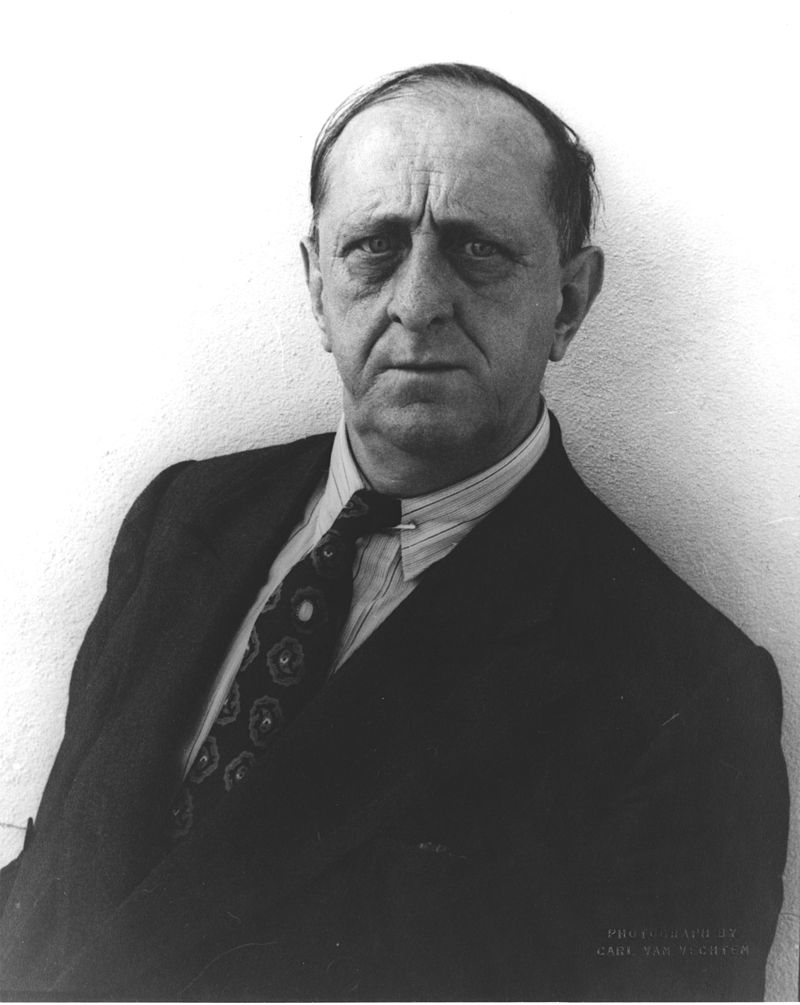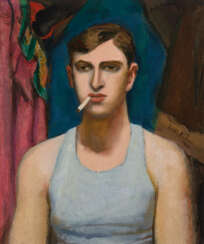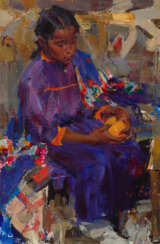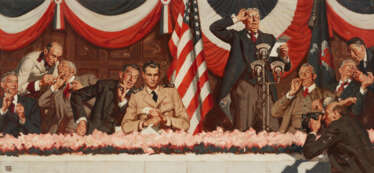
Paintings — Modern American Art

Walter Francis Kuhn is an American artist who occupies a place in American art history as an accomplished caricaturist, draftsman, engraver, sculptor, and painter. His cycle of portraits of circus and vaudeville performers is world famous. He was also the organizer of the famous 1913 Armory Exhibition, which was America's first large-scale introduction to European modernism.

Milton Clark Avery was an American artist who, with his wife, the artist Sally Michelle Avery, created his own "Avery style. Avery was one of the most influential abstract artists in the United States in the mid-20th century.
His work is characterized by bright colors and recognizable geometric shapes. He often used these elements to create abstract compositions in which he placed great emphasis on the harmony of color and line. In addition to abstract works, Avery also created figurative paintings, often depicting landscapes and portraits. He used bright colors and strong contrasts to create emotional depth in his works.
Avery's work is held in many museums, including the Museum of Modern Art in New York, the Guggenheim Museum, and the National Gallery of Art in Washington, DC.

Milton Clark Avery was an American artist who, with his wife, the artist Sally Michelle Avery, created his own "Avery style. Avery was one of the most influential abstract artists in the United States in the mid-20th century.
His work is characterized by bright colors and recognizable geometric shapes. He often used these elements to create abstract compositions in which he placed great emphasis on the harmony of color and line. In addition to abstract works, Avery also created figurative paintings, often depicting landscapes and portraits. He used bright colors and strong contrasts to create emotional depth in his works.
Avery's work is held in many museums, including the Museum of Modern Art in New York, the Guggenheim Museum, and the National Gallery of Art in Washington, DC.

Edward Stuart Davis was an American artist, a representative of Cubism and Pop Art in painting. He was also active in politics; one of Davis's goals was to "reconcile abstract art with Marxism and modern industrial society. Along with his paintings, Davis was also an engraver and member of the Society of American Graphic Artists.

John French Sloan was an American impressionist painter, considered one of the founders of the Ashcan school of American art. He is best known for his urban, everyday genre scenes and his ability to capture the essence of New York City neighborhood life, which he observed from his studio window in Chelsea.

Maxfield Parrish was an American painter and illustrator active in the first half of the 20th century. He is known for his distinctive saturated hues and idealized neo-classical imagery. His career spanned fifty years and was wildly successful: the National Museum of American Illustration deemed his painting Daybreak (1922) to be the most successful art print of the 20th century.

Jamie Wyeth, or James Browning Wyeth, is an American realist painter, the son of Andrew Wyeth and grandson of N.K. Wyeth. He is the artistic heir to the tradition of the Brandywine School, artists who worked in the Brandywine River countryside of Delaware and Pennsylvania, depicting its people, animals, and landscapes. He works successfully in drawing, lithography, etching, egg tempera, watercolor, and mixed media.

Andrew Newell Wyeth, an American visual artist, is renowned for his mastery in realism and regionalism. Born in 1917 in Chadds Ford, Pennsylvania, Wyeth was primarily a realist painter, deeply influenced by his father, N.C. Wyeth, a notable artist himself. Andrew's artwork, characterized by its clear, razor-sharp technique and a hauntingly eerie atmosphere, often depicted the land and people around him in rural Pennsylvania and Maine.
Wyeth's most celebrated work, Christina's World (1948), is housed in the Museum of Modern Art in New York City. This painting illustrates a woman lying in a field, looking toward a distant farmhouse, an image that has become an icon of American art due to its emotional depth and simplicity of composition. The work encapsulates Wyeth's ability to invoke profound personal and emotional landscapes through the meticulous depiction of physical settings and figures.
Andrew Newell Wyeth continued painting almost up until his death in 2009, leaving behind a vast legacy that has influenced many artists. His works remain highly valued by collectors and are often featured in major museums and galleries worldwide. To stay updated on exhibitions and sales of Andrew Wyeth’s art, sign up for our newsletter—ensuring you're informed about the latest auction events and product sales related to this profound artist.

Peter Hurd was an American painter whose work is strongly associated with the people and landscapes of San Patricio, New Mexico. He is equally acclaimed for his portraits and his western landscapes. His large egg tempera paintings earned him national recognition. During World War II, Hurd worked for Life magazine as a war correspondent attached to the US Air Force. He covered almost all the fronts of the far-flung battle line, creating hundreds of "War Sketches" that range from poignant to comic. Some of Hurd’s most well-known portraits were of his neighbors, family, and friends at Sentinel Ranch. He loved to paint people who were deeply connected to the land, and always showed them outdoors, against the hills and sky. Many of Hurd's works can be seen at the Hurd-La Rinconada Gallery in San Patricio, New Mexico.

Oscar Edmund Berninghaus was an American artist and a founding member of the Taos Society of Artists. He is best known for his paintings of Native Americans, New Mexico and the American Southwest. His son, Charles Berninghaus (1905–1988), was also a Taos artist.

Robert Henri was an influential American painter and teacher, born on June 25, 1865, in Cincinnati, Ohio. He played a pivotal role in the Ashcan School, a movement that sought to depict urban life in a realistic manner. Henri's work was known for its vibrant brushwork and focus on everyday subjects.
Henri's early career was marked by a strong influence from European modernist styles, which he encountered during his studies in Paris at the Académie Julian. Despite his classical training, he later rebelled against the rigid conventions of academic art in America. This rebellion was epitomized in 1908 when he organized an exhibition for The Eight, a group of like-minded artists, which showcased their more realistic and expressive urban scenes.
Throughout his career, Henri also dedicated himself to teaching, influencing a generation of artists, including Edward Hopper and George Bellows. He encouraged his students to portray real life and to express their individual perspectives through art. Henri's teaching and artistic philosophies left a lasting impact on American art, bridging the gap between traditional techniques and modernist experiments.
To stay updated on exhibitions, sales, and auction events featuring the captivating works of Robert Henri, sign up for our newsletter. This service offers exclusive insights and opportunities for collectors and art enthusiasts to engage deeply with Henri's legacy. Don't miss out on the chance to explore more about this pivotal figure in American realism.

Nikolai Ivanovich Fechin (Russian: Николай Иванович Фешин) was a Russian and American artist of the first half of the twentieth century. He is known as a painter, master of domestic and portrait genres, representative of Impressionism and Art Nouveau. Nikolai Fechin was also a graphic artist, sculptor, and carver, and at the initial stage of his professional career he showed himself as a teacher.
Nikolai Fechin spent a considerable part of his life in emigration, where he quickly managed to achieve recognition and commercial success. He created more than two thousand works, which are now scattered around the world. The largest collection of Fechin's works is in Russia in the Museum of Fine Arts of Tatarstan. And some of his works are in the collections of more than thirty museums in the United States, as well as in private collections.

Nikolai Ivanovich Fechin (Russian: Николай Иванович Фешин) was a Russian and American artist of the first half of the twentieth century. He is known as a painter, master of domestic and portrait genres, representative of Impressionism and Art Nouveau. Nikolai Fechin was also a graphic artist, sculptor, and carver, and at the initial stage of his professional career he showed himself as a teacher.
Nikolai Fechin spent a considerable part of his life in emigration, where he quickly managed to achieve recognition and commercial success. He created more than two thousand works, which are now scattered around the world. The largest collection of Fechin's works is in Russia in the Museum of Fine Arts of Tatarstan. And some of his works are in the collections of more than thirty museums in the United States, as well as in private collections.

Fremont F. Ellis was an American impressionist painter who expressed a deeply intuitive perception of nature in his works.
He painted in a style strongly influenced by the Impressionists, using bold strokes and vivid colours to convey light and atmosphere in his landscapes. Being self-taught, he joined a well-known group of young Santa Fe artists, Los Cincos Pintores. For nearly 70 years Ellis drew inspiration from the beauty of New Mexico's landscapes.
Ellis' work continues to influence contemporary artists. His work has been exhibited in many galleries in New York, London and Paris. Ellis received many prestigious awards during his career, including the Julian Medal and the Gold Medal at the Paris Salon in 1930. His work is held in several museums, including the Harwood Art Museum in Taos, New Mexico, and the National Museum of American Art in Washington, D.C.

Ernest Martin Hennings (Jr.) was an American artist and member of the Taos Society of Artists. In 1901 that Hennings began taking classes at the School of the Art Institute of Chicago, which was largely based on the great European art schools and made particularly emphasis on the importance of drawing. Hennings took up work as a commercial artist, mostly painting murals and portraits around Chicago. Hennings' primary interest was in portrait painting, with his primary subject being the Native Americans living in and around Taos Pueblo. In 1922 he was awarded the Clyde M. Carr Prize from the Art Institute of Chicago as well as the Institute's Fine Arts Building Prize. By the 1920s, the now established painter was building his reputation on the national scene, with exhibitions and awards including. Many art collectors throughout America sought out his paintings. Today paintings by Hennings are housed in the Smithsonian American Art Museum, Stark Museum of Art, Booth Western Art Museum etc.

Norman Rockwell was an American illustrator and painter, renowned for his vivid and humane portrayal of American life. Born in New York City in 1894, Rockwell showed artistic promise from an early age, which led him to leave high school and pursue art full-time at prestigious institutions like the National Academy of Design and the Art Students League.
Rockwell's career blossomed early; by the age of 22, he had painted his first cover for The Saturday Evening Post, a relationship that would last nearly five decades and produce 323 covers. His depictions of everyday life and pivotal American moments captured the spirit of the nation.
Perhaps his most significant works were the "Four Freedoms" series, inspired by President Franklin D. Roosevelt's vision of a world founded on four essential human freedoms. These paintings not only graced the covers of The Saturday Evening Post but also played a crucial role in the U.S. war effort during World War II, raising over $130 million through the sale of war bonds.
In his later years, Rockwell did not shy away from addressing social issues. His move to Look magazine allowed him to focus on subjects such as civil rights and poverty, marking a significant shift from his earlier work. "The Problem We All Live With," depicting Ruby Bridges integrating a New Orleans school, remains a powerful symbol of the Civil Rights Movement and showcases Rockwell's ability to engage with contemporary social issues through his art.
For those interested in exploring Rockwell's extensive body of work, the Norman Rockwell Museum in Stockbridge, Massachusetts, holds the largest collection of his original art, providing insights into his artistic journey and the historical context of his works.
If you're keen on further updates and insights into the world of Norman Rockwell, consider signing up for our newsletter. This subscription will keep you informed about new exhibitions, sales, and auction events related to Rockwell's art.

Dean Cornwell was an American illustrator and muralist. His oil paintings were frequently featured in popular magazines and books as literary illustrations, advertisements, and posters promoting the war effort. Throughout the first half of the 20th century he was a dominant presence in American illustration. At the peak of his popularity he was nicknamed the "Dean of Illustrators". He began his professional career as a cartoonist for the Louisville Herald. Soon thereafter he moved to Chicago, where he studied at the Art Institute and worked for the Chicago Tribune. Cornwell's paintings were in Cosmopolitan, Harper's Bazaar, Redbook, and Good Housekeeping magazines. He painted murals for the Los Angeles Public Library, the Lincoln Memorial Shrine in Redlands, California etc. Cornwell taught and lectured at the Art Students League in New York. He served as president of the Society of Illustrators from 1922 to 1926, and was elected to its Hall of Fame in 1959.
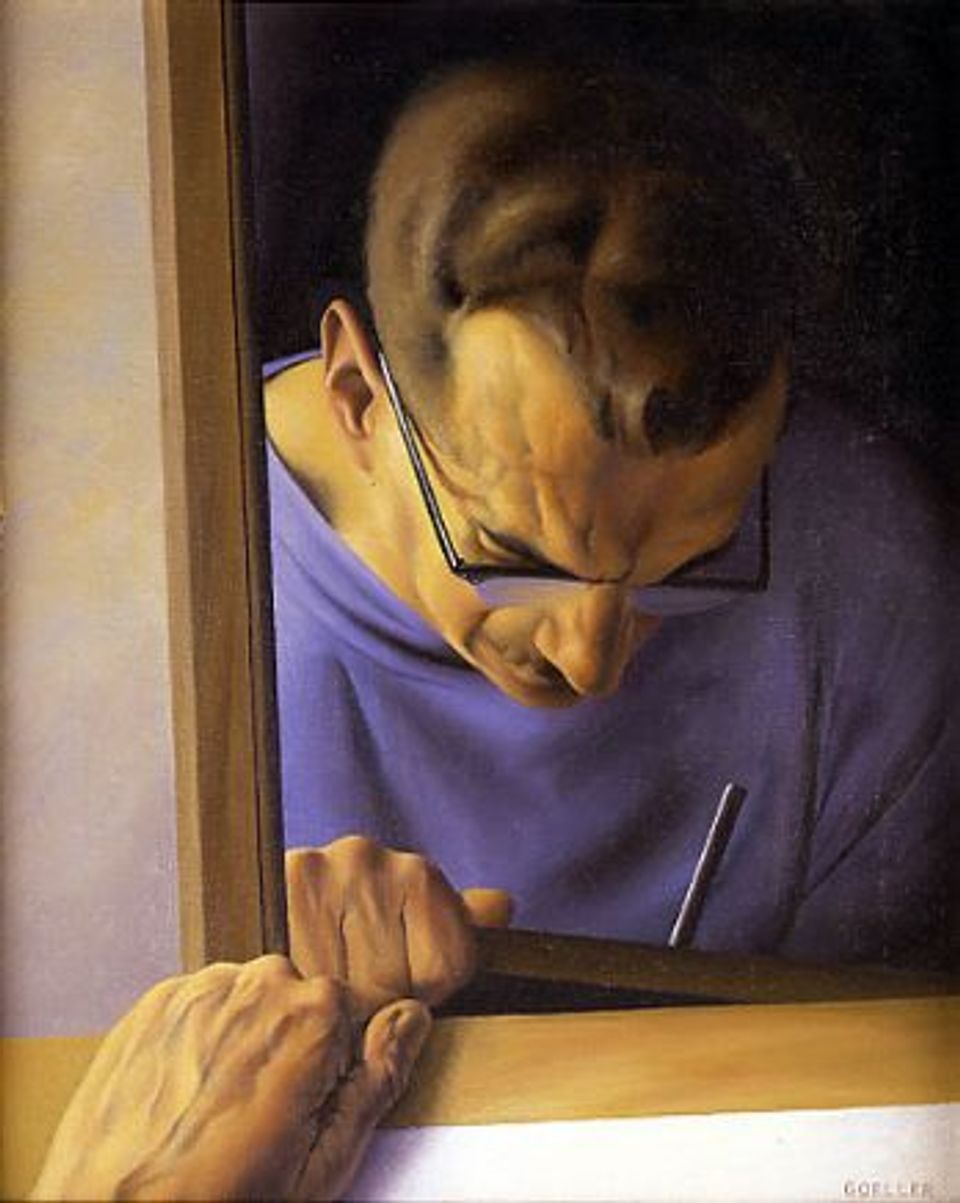
Charles Louis Goeller was an American artist best known for his precise and detailed paintings and drawings, in which he once said he sought to achieve "emotion expressed by precision." Among the subjects of his work are still lifes, portraits, and cityscapes.

Rockwell Kent is an American artist, illustrator, and writer. He was born and raised in New York City and began his art career in the early 1920s.
Kent worked in a variety of genres and styles, including realism, expressionism, and cubism. Kent became known for his book illustrations as well as his paintings and prints. His work was frequently published in Harper's Weekly, The New York Times, and Vanity Fair magazines and newspapers.
He also illustrated many books, including famous works by Ernest Hemingway and Herman Melville. Kent was also an activist and political activist. He was an advocate of socialist ideals and participated in political movements. In addition, he was a traveler and explorer, having made several trips to Alaska and other far northern territories.
Kent was also a writer and author of several books, including the autobiographical novel It's Me, O Lord! and a book about his travels. Kent's style was recognizable and original, and he was known for his powerful compositions, bright colors, and pronounced contours. His work remained popular even after his death in 1971, and many can be seen in museums and art galleries around the world.

Rockwell Kent is an American artist, illustrator, and writer. He was born and raised in New York City and began his art career in the early 1920s.
Kent worked in a variety of genres and styles, including realism, expressionism, and cubism. Kent became known for his book illustrations as well as his paintings and prints. His work was frequently published in Harper's Weekly, The New York Times, and Vanity Fair magazines and newspapers.
He also illustrated many books, including famous works by Ernest Hemingway and Herman Melville. Kent was also an activist and political activist. He was an advocate of socialist ideals and participated in political movements. In addition, he was a traveler and explorer, having made several trips to Alaska and other far northern territories.
Kent was also a writer and author of several books, including the autobiographical novel It's Me, O Lord! and a book about his travels. Kent's style was recognizable and original, and he was known for his powerful compositions, bright colors, and pronounced contours. His work remained popular even after his death in 1971, and many can be seen in museums and art galleries around the world.

Rockwell Kent is an American artist, illustrator, and writer. He was born and raised in New York City and began his art career in the early 1920s.
Kent worked in a variety of genres and styles, including realism, expressionism, and cubism. Kent became known for his book illustrations as well as his paintings and prints. His work was frequently published in Harper's Weekly, The New York Times, and Vanity Fair magazines and newspapers.
He also illustrated many books, including famous works by Ernest Hemingway and Herman Melville. Kent was also an activist and political activist. He was an advocate of socialist ideals and participated in political movements. In addition, he was a traveler and explorer, having made several trips to Alaska and other far northern territories.
Kent was also a writer and author of several books, including the autobiographical novel It's Me, O Lord! and a book about his travels. Kent's style was recognizable and original, and he was known for his powerful compositions, bright colors, and pronounced contours. His work remained popular even after his death in 1971, and many can be seen in museums and art galleries around the world.

Dale William Nichols was an American landscape painter whose work included illustrations, paintings, lithographs, and woodcarvings. His favorite subject is rural landscapes, often snow-covered. Nichols' paintings are represented in many public and private collections across the country, including the Art Institute of Chicago. His most famous oil painting, End of the Hunt, hangs in the Metropolitan Museum of Art.

Wolf Kahn was a German-born American artist who painted mostly landscapes. Kahn worked in oil and pastel, and his style has been described as a combination of picturesque landscapes and painterly abstraction.

Wolf Kahn was a German-born American artist who painted mostly landscapes. Kahn worked in oil and pastel, and his style has been described as a combination of picturesque landscapes and painterly abstraction.

Wolf Kahn was a German-born American artist who painted mostly landscapes. Kahn worked in oil and pastel, and his style has been described as a combination of picturesque landscapes and painterly abstraction.

Sally Michel Avery is an American artist known for her paintings in the style of abstract expressionism. Her paintings are often associated with musical rhythm and melody. She began her career as a landscape painter, and in the 1940s she moved to more abstract forms and color schemes.
Avery was one of the few women recognized as influential in American abstract painting in the mid-20th century. Her work can be seen in museums and private collections around the world.





